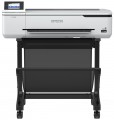Paper size
The paper size the plotter is designed to operate with. Most models use ISO 216 formats, identified by the letter A followed by a digit. These formats include the popular A4, but plotters usually work with larger paper:
- A0+. This marking means that the plotter is able to work with sheets larger than A0 (see below). The A0+ format itself provides a sheet width of 914 mm, however, in this case, support for wider media is usually provided — about 1100 mm (1050 – 1150 mm) in the most modest models of this format ( A0+ 44 ") and 1500 mm or more in the largest ( A0+ ≥ 60")
- A0. Paper of this format has a size of 1189x841 mm.
- A1. Paper size 841x594 mm — in other words, half of the A0 format.
- A2. A sheet of this format is approximately the size of a newspaper spread — 420x594 mm, half the size of A1. Considered relatively small by plotter standards.
- A3. The smallest format found in modern plotters: 297x420 mm, that is, only twice the standard A4 (in other words, with a magazine spread). Used in few desktop models (see Installation) — particularly, textile devices (see Product Type) for printing on T-shirts and other similarly sized clothes.
It is also worth noting that many models are able to work with other sizes. Moreover, we are talking not only about reduced, but also about la
...rger options: the maximum media width (see below) often exceeds the standard paper size.Sheet printing time
Approximate time taken by the plotter to print one sheet.
This indicates for the paper size that the machine was originally designed for (see "Paper Size"). And it is approximate because it is usually given for optimal or almost optimal printing conditions: low quality and resolution, relatively simple images, etc. So the actual print time of the sheet may differ from the claimed one in one direction or another, depending on the operating parameters — starting from the mentioned quality and resolution to the type of media. However, according to the figures indicated in the specs, it is quite possible to evaluate different models and compare them with each other: the difference in the claimed time, usually, will proportionally correspond to the difference in the actual printing speed.
It is also worth noting that this time is usually indicated by the duration of the printing process itself — from the capture of the sheet by the feeder to the output of the completed print from the device. Interruptions inevitably occur between printing individual sheets, so that the total printing time is longer than the printing time of a sheet multiplied by the number of sheets. For example, a device with a time consumption of 36 sec per sheet theoretically should print about 100 sheets per hour (1 h = 3600 s, 3600/36 = 100), but in fact such a plotter usually produces about 70 – 75 sheets in this time.
Media width (max)
The largest width of paper or other media that the plotter can handle. The larger this parameter, the larger the materials that can be printed on the device; however, the dimensions, weight and cost of the plotter also increase markedly due to this.
Max. roll diameter
The largest roll diameter that can be installed in a plotter with roll printing (see above). This parameter is useful primarily for the selection of media: the material of the same width can be produced in rolls of different diameters.
Cartridge model
Models of cartridges used in the plotter. With this info, you can easily find original consumables for the device.
Noise level
The maximum noise level produced by the plotter during operation. The lower this indicator, the less inconvenience to others the device will create. At the same time, in modern plotters, the noise level usually does not exceed 60 dB, which is comparable to a TV set at an average volume; and many of them do not "reach" even up to 50 dB, corresponding to a quiet conversation at a distance of 2-3 m. And if we also take into account the fact that plotters are usually used in industrial premises, then we can say that in most cases this indicator does not play a significant role.
Power consumption
Rated power consumption of the plotter. Usually specified by the maximum value — for the print mode, when the device requires the most power.
The heavier and more performant the device, the higher its power consumption in general. At the same time, models that are similar in performance may differ in this indicator. And here it is worth proceeding from the fact that a more energy-efficient unit usually costs more, but with intensive use, this difference can quickly pay off due to energy savings.
In addition, the power consumption may be necessary for special electrical calculations — for example, determining the necessary parameters of a voltage stabilizer, a backup generator, etc.
Main unit dimensions (WxDxH)
Dimensions of the main unit of the device. For desktop models (see "Placement") this is the total size of the entire plotter, it is a spec you need to focus on while choosing a model and evaluating a place for installation. For floor-standing devices, the dimensions are indicated here without taking into account the stand, so this parameter plays a minor role and can be useful mainly for storing or transporting the device in disassembled form.
Dimensions with stand (WxDxH)
The overall dimensions of the floor plotter (see “Placement”), including the stand, in other words, the dimensions of the device in the operative condition (in addition to the stand itself, other equipment, such as trays for printed materials, is taken into account here). This indicator is worth evaluating how much space is needed to install such a plotter.

